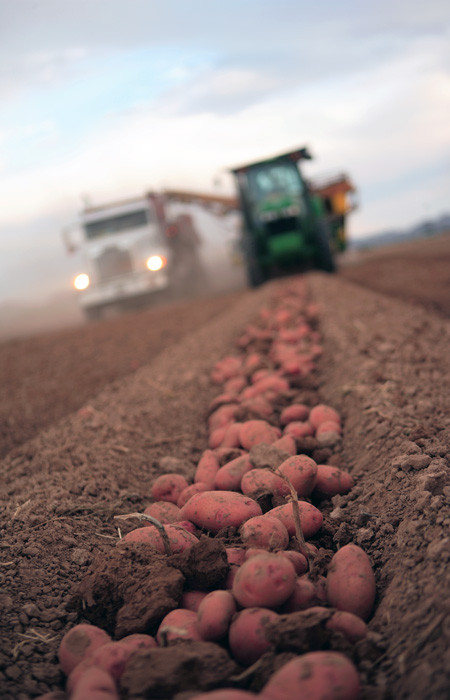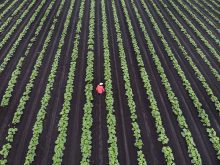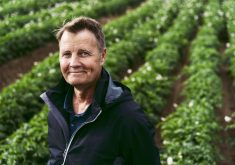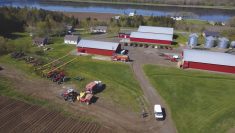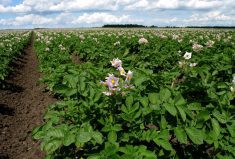The potato genome is a medium-size plant genome, consisting of 12 chromosomes with a haploid length of about 840 million base pairs. In 2011, it was successfully sequenced through the efforts of the Potato Genome Sequencing Consortium (PGSC), an initiative of the Netherlands Genomics Initiative and Wageningen University and Research Centre that combined the efforts of 16 different national research groups around the world.
While in the early 2000s Canada had a role in contributing short sequences and laying some of the groundwork for the genome project, it was not part of the PGSC. But armed with the completed potato genome, Canadian researchers have been doing groundbreaking work in potato breeding using next generation genetic sequencing technologies.
Read Also

Could crop sharing be a viable option for your farm?
Crop sharing could be a good option for young and beginning farmers.
At Agriculture and Agri-Food Canada’s Fredericton-based Potato Research Centre, research scientist Helen Tai, along with leading potato geneticist David De Koeyer, work to identify key genes in potato that will contribute genetic markers to potato breeding projects.
According to Tai, the cost of genetic sequencing has dropped dramatically in 20 years. “The cost of sequencing was a billion dollars in the past and you can now pay for it on a Visa card,” she says.
Until recently, geneticists had relied on dideoxy DNA sequencing technology, developed by Nobel laureate Frederic Sanger in the 1970s. In the last several years, next generation technologies have developed that speed up the process of large-scale genome analysis — and cost much less. Combined with innovations in computer software, sequencing technologies offer researchers much more efficient routes to improved potato germplasm.
“When the cost drops you can see how using DNA markers in breeding can become more commonplace,” says Tai. “So what we’re doing is genetic testing of our individual breeding lines. Another shift in the way we do things is that we will sequence whole genomes and use computers to help us figure out where there are important genes.
“I make an analogy to online dating where a computer algorithm is used to find the best match between individuals — we’re doing this in potatoes,” says Tai.
- More on potatoes from Country Guide: Wild varieties
Marked advantage
With the potato genome sequenced, researchers have the ability to locate each of the potato’s genes, or DNA sequences, and “mark” them. DNA sequences demonstrate each variety’s differences, their individual variations, from other varieties. Researchers can now more easily find those genetic markers that express disease resistance or other traits — positive or negative — in potato varieties.
One of the positive results to come out of the DNA sequencing technology is positive selection markers, says Tai.
“There are some we’re using already — for resistance to potato cyst nematode and late blight. We’re integrating these into our breeding,” she says. “What’s exciting for us is to bring the cycle of breeding from 10-15 years down to five years. We’re trying to reach better potato varieties faster.”
This has the positive corollary of making breeding more responsive to the markets, so that breeders can focus their efforts on particular areas of disease resistance when pest cycles change, for example. Some years, Colorado Potato Beetle is less of a concern than in others, and Potato Cyst Nematode is more important. Next generation sequencing technology allows breeders to develop varieties that respond in a highly practical way to growers’ dominant concerns.
“We want to be responsive to the market and take advantage of those opportunities, and support the industry where it needs new traits,” says Tai.
Other emerging markets for potatoes, which involve their application in bioplastics or pharmaceutical products, or alternative food uses, also demand certain traits in potato, and with a faster “turnaround” for new potato varieties, breeders can take those new market demands into consideration as well.
Priorities
While there are plenty of potential applications for potatoes that demand certain sets of traits, Tai says there are priorities in potato breeding. First, potato breeders operate under some scientific restrictions that limit how much individual traits can be improved. They must also abide by industrial priorities, which focus on yield and dry matter, for example.
As disease traits can be tested easily in the laboratory, sometimes the markers that are developed are those that apply to disease rather than to yield. “Yield is very difficult — it’s a highly complex trait and shows a lot of environmental variation,” explains Tai.
Environmental priorities include a focus on traits that will reduce the necessity for the use of chemicals in the field, or nutrient-use efficiency so growers can ultimately reduce their reliance on fertilizers. “You have to be selective as to what’s needed at any particular time, and ask the industry what they’re seeing as a priority in terms of what they’d like to pick up. Behind all of that is always what the grower needs to maintain their profitability,” says Tai. What the grower identifies as top concerns can include nutrient-use efficiency and yield.
There are also priorities for human health. In the mid-2000s the Bio-Potato Network was formed to focus research efforts on the potential for health benefits in potato metabolites. Among other things, the Network, which ended in 2011, looked at the antioxidant content of pigmented potatoes. Antioxidants can help offset diseases associated with oxidative stress, and they are present in the form of anthocyanin in orange and yellow, purple and pink potatoes. These are the same antioxidants present in berries, according to Tai, and the fresh market is beginning to trend toward pigmented tubers.
The Potato Research Centre and National Research Council in Prince Edward Island were partners in the BioPotato Network, and examined health attributes of potato. “We looked at molecular and cellular assays for human health — they applied the potato metabolites and looked at the cells to see if there could be some benefits,” she says.
Potato geneticists and breeders are more equipped now than at any other point in history to develop potatoes with enhanced characteristics in a short time, armed with the potato genome and the technologies to unlock its potential.
“We’re combining the strength of the computer with the breadth of data across the genome,” says Tai.
Julienne Isaacs is a Winnipeg-based freelance writer and editor. This article first appeared in the 2014 National Potato Guide


